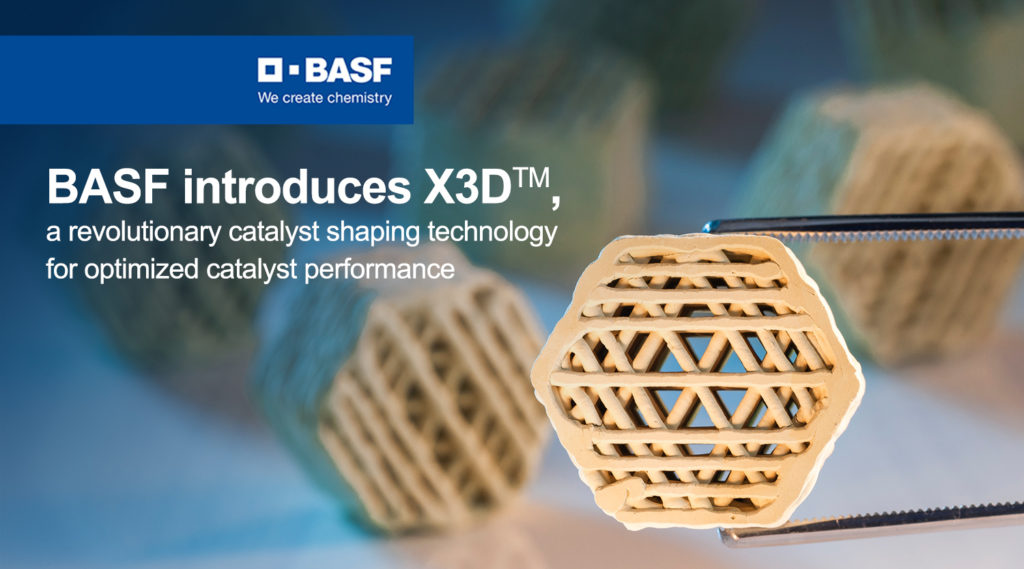As the world’s largest chemical company, Germany’s BASF has the experience and the need to improve its own production capabilities. With the release of its new X3D, the conglomerate has implemented additive manufacturing (AM) to do just that. By 3D printing catalysts for chemical manufacturing, BASF is able to improve the performance of the materials for overall better output.
What Is a Catalyst?
Catalysts are essential materials for speeding up a chemical reaction without themselves experiencing permanent chemical modifications. Roughly 90% of chemical products, from bulk materials like ammonia and methanol to fine chemicals for drug production, are made commercially rely on catalysts during some step of the manufacturing process.
Beyond these, catalysts are also key for energy production, such as petroleum refinement and fuel cell operation, and food processing. Moreover, by speeding up industrial operations, they can reduce those operations’ impact on the environment. However, they may negatively impact the environment at the same time through the release of toxic byproducts, like free radicals.
BASF’s Catalyst 3D Printing Technology
The use of AM makes it possible to produce catalysts with unique geometries. By 3D printing them with open geometries, BASF is able to improve the performance of catalysts by increasing their surface area and thereby reducing the pressure drop across a reactor. The specific shapes—including infill pattern, fiber diameter and orientation—can all be tailored to a customer’s specific needs with the potential to increase reactor output, improve product quality, and lower energy consumption.
BASF has demonstrated the viability of these 3D printed catalysts by running them in commercial plants both outside and inside of the business for several years. The company describes them under operating conditions as “mechanically robust and proven.” Now, BASF is ready to supply them at commercial volumes, beginning with BASF’s sulfuric acid catalysts O4-111 X3D and O4-115 X3D. BASF’s technical service team will collaborate with its customers to tailor these products to their specific projects.
“With this technology, we are able to provide catalysts that are tailored to our customers’ needs to help significantly boost their plant performance while reducing energy consumption and increasing sustainability at the customer level”, said Detlef Ruff, Senior Vice President, Process Catalysts at BASF.
What is Sulfuric Acid Used for?
BASF’s sulfuric acid products were first patented in 1913, before the company had created IG Farben to support the Nazi war effort. Sulfuric acid itself is a material that is essentially intrinsic to industrial civilization, with about 60 percent of the world’s supply used to produce fertilizer and 20 percent dedicated to manufacturing chemicals ranging from detergents and pharmaceuticals to pesticides and antifreeze.
It’s also used as a catalyst for the manufacturing of other chemicals, such as Nylon, to make nylon, an important polymer for the AM sector and BASF. By designing its O4-111 X3D and O4-115 X3D for the production of sulfuric acid, the company not only supports its customers but its supports itself.
The Impact of 3D Printing Sulfuric Acid Catalysts
While we might like to say that improving the efficiency of the catalyst would improve the ecological impact of a number industries, that would be a challenging argument to make. Sulfuric acid’s role in the production of phosphate fertilizers and the refining of petroleum, for instance, suggests that the material is actually fueling environmental destruction. At the same time, because industrial civilization doesn’t seem to be slowing its use of these materials, we might consider an improvement in their efficiency to be marginally less negative than the alternative.
Regardless of the ecological pros and cons of 3D printed catalysts, the real story here may be how far BASF is going to adopt and promote AM. This is an entirely unique application of the technology that demonstrates the use cases for 3D printing that have yet to be discovered across a wide range of fields. If BASF can manufacture these two catalysts at scale, they are adopted widely, and have the sort of impact the company suggests, then we could see that trickle across not only BASF’s range of products, but the entire chemical industry and beyond. In other words, we’ve only just begun to scratch the surface of what AM is capable of and in what industries.
Subscribe to Our Email Newsletter
Stay up-to-date on all the latest news from the 3D printing industry and receive information and offers from third party vendors.
You May Also Like
Precision at the Microscale: UK Researchers Advance Medical Devices with BMF’s 3D Printing Tech
University of Nottingham researchers are using Boston Micro Fabrication‘s (BMF) 3D printing technology to develop medical devices that improve compatibility with human tissue. Funded by a UK grant, this project...
3D Printing Webinar and Event Roundup: April 21, 2024
It’s another busy week of webinars and events, starting with Hannover Messe in Germany and continuing with Metalcasting Congress, Chinaplas, TechBlick’s Innovation Festival, and more. Stratasys continues its advanced training...
3D Printing Webinar and Event Roundup: March 17, 2024
It’s another busy week of webinars and events, including SALMED 2024 and AM Forum in Berlin. Stratasys continues its in-person training and is offering two webinars, ASTM is holding a...
3D Printed Micro Antenna is 15% Smaller and 6X Lighter
Horizon Microtechnologies has achieved success in creating a high-frequency D-Band horn antenna through micro 3D printing. However, this achievement did not rely solely on 3D printing; it involved a combination...






























